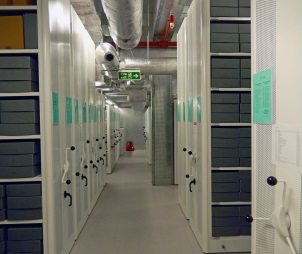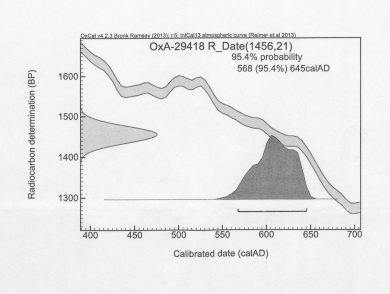
Forming part of the collections of the Cadbury Research Library, the Birmingham Qur’an is preserved in a secure and climate-controlled environment. Mindful of the sacred nature of the text, the Birmingham Qur’an manuscript is cared for with the utmost respect. It has been conserved by a specialist in Islamic manuscript conservation and placed in an Islamic-style binding with fore-edge flap to protect it.
The graph of the radiocarbon result for the parchment from the University of Oxford's Radiocarbon Accelerator Unit shows the date range of 568-645 with 95.4% probability.
Research into material evidence of early Qur’anic textual history is an emerging field. After the launch of the Coranica Project, which investigated physical evidence of early Qur'anic text, the Cadbury Research Library decided to have this manuscript radiocarbon dated independently. This was carried out by the University of Oxford's Radiocarbon Accelerator Unit, to enhance scholarly understanding. The testing was commissioned as a commercial service from Oxford and the University of Birmingham shared these results with the world in July 2015 and subsequently mounted an exhibition in October 2015 to fulfil public demand to see the manuscript.
This Qur’an has been studied by international academics since the 1930s when it first arrived in Birmingham. It was originally catalogued as 8th or 9th century in the 1940s. Dr Alba Fedeli was studying for her PhD at the University of Birmingham. She used paleographic analysis - the study of old handwriting - to identify the script as Ḥijāzi, an early form of Arabic that dates from the seventh century.
The radiocarbon testing of a fragment of the parchment (made of goatskin or sheepskin) at the University of Oxford's Radiocarbon Accelerator Unit placed the sample into a seventy-seven-year time period of 568-645 with 95.4% probability. The event dated by radiocarbon analysis is the date of death of the animal whose skin was used to make the manuscript on which the text is written.

In 2017 the University commissioned further scientific work on the manuscript to examine whether there is any hidden writing that could not be seen with the naked eye. This process, called multi-spectral imaging, carried out by R B Toth Associates in conjunction with the Cadbury Research Library, examines the manuscript through different wavelengths of light. The results (below) showed no hidden text within the manuscript, proving that it is not a palimpsest (a recycled parchment) and that the writing visible to the naked eye is the first use of the parchment as a manuscript. A short film of multispectral imaging analysis of the parchment and inks can be viewed on the University's YouTube channel.
